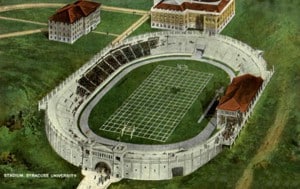
To understand where the popular term “gridiron” originated, first we have to go back to the 14th century, when the word became commonly used to describe a metal grid for cooking over a fire.
Now fast-forward to the late 19th century and early 20th century, when football as we know it today was just starting to distinguish itself from older, related games like rugby and associate football (now known as soccer).
In addition to the use of hard plastic helmets and shoulder pads, the forward pass, a line of scrimmage and other unique traits, one of the most defining characteristics of football was the playing field. Until the early 1920s, football fields were marked in a checkerboard (or grid) pattern, resembling a gridiron.
In a 1911 issue of Outdoor Sports and Games, sports writer Claude H. Miller forever cemented the term “gridiron” to this new-fangled sport when he wrote:
“The lines on a football field make a checkerboard effect and have given to the field the name of ‘gridiron.'”
In time, the grid system was ditched for the yard lines and hash marks that we still use today, but the term “gridiron” stuck.
Codes of Gridiron Football
Though nowadays gridiron football is synonymous with American football, originally it was used as a blanket term for the primarily North American game in all its variants and forms. Other gridiron football codes include:
-
- Canadian football – played almost exclusively in Canada. The game is played on a 110-yard field, has only three downs and twelve men per team. Unlike most versions of American football, the Canadian game allows players to move toward the line of scrimmage prior to the snap, and also has a “single” score-one point for a ball kicked into the end zone and not returned by the receiving team.
-
- Nine-man, eight-man and six-man football – variations of the traditional gridiron football game with fewer players. These football codes are often played with a 15-yard minimum per down, fewer offensive linemen and a smaller field.
-
- Indoor football – played on a 50-yard indoor field with seven or eight players to a side. Each indoor football league typically has its own rulebook.
- Touch or Flag football – casual versions of the game with no universal recognized rules.
So next time a game commentator mentions the term “gridiron,” you can impress your buddies with this newfound knowledge.
Whether you play in a league or simply enjoy backyard pickup games with your friends and family, get all of your high-quality gridiron footballs and team memorabilia from Big Game USA’s college football store. Big Game is a premier supplier of competitive footballs for FBS, Division-I college football teams across the U.S.
Click here to see which teams use a Big Game-made ball…
